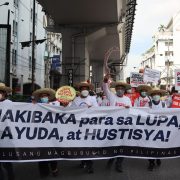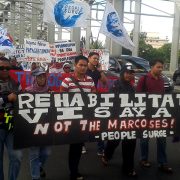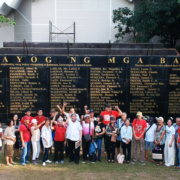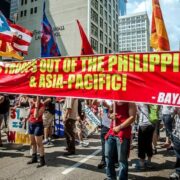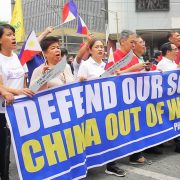2 Trillion Pesos: Rice to feed Filipinos for the next 3 decades or cold bullets from the US?
2 years on as President, where is Ferdinand Marcos Jr. taking the Filipino people?

Contributed by Jezrel V. Curambao and Joshua Reyes
DESPITE facing severe social and economic problems, such as skyrocketing prices and impoverished living conditions, President Ferdinand Marcos Jr. has approved a massive military budget for the defense department. A total of PhP2 trillion will be allocated to the AFP (Armed Forces of the Philippines) modernization project over the next decade. Even under the current economic woes of the Filipino people, such as extremely high rice price, this amount could provide the people’s staple food for 31 years. Considering the impact of the rising costs of living, it becomes imperative to assess the feasibility and affordability of a PhP2 trillion military budget.
Living cost is skyrocketing but household income continues to dive
While the defense sector is undeniably important, it is crucial to strike a balance that does not burden the Filipinos too much. Since Marcos Jr. took office, the domestic inflation rate has continuously risen, from 2.4% in 2019 to 6% in 2023, doubling in just a couple of years. This also means that the people’s costs of living keep rising. According to data from the Philippine Statistics Authority (PSA), the domestic consumer price index has increased from 102.4 in 2019 to 145.97 in 2023, representing a 42.2% increase in prices of daily necessary goods. Even non-staples such as mangoes, which used to sell for about 88 pesos per kilogram in 2019, now costs 125 pesos per kilogram.
Going back to rice, the Philippine Rice Research Institute reported a sudden increase in retail rice prices under Marcos Jr. From 38 pesos per kilogram in 2016, it has risen to the current 46 pesos per kilogram, an increase of 19%. And it is expected to increase even more this year.
In contrast, the employment rate remains consistently low while the poverty rate has also increased. The situation is far from optimistic. Unemployment rates under President Marcos’s administration are much higher than pre-pandemic levels, with many young people facing the dilemma of unemployment and low wages. According to the PSA, the youth unemployment rate in the Philippines in 2023 is 10.5%, with approximately 12.14 million young people without jobs and income. As the mainstay of the Philippines’ economic development, the youth could use more policy and financial support. Additionally, PSA data also show, for the first quarter of 2023, the percentage of the population below the national poverty line is 22.4%. This means that there are 25.89 million people in the country whose daily income is lower than 126 pesos (approximately 2.15 US dollars). The PhP2 trillion military budget should be used to provide more education resources and opportunities for the unemployed and impoverished people, particularly the youth, to stimulate economic growth and create job opportunities, or to ensure the basic livelihoods of the extremely poor population.
Another important consideration is the potential impact on essential sectors such as education and health. According to the Department of Budget and Management (DBM), the education department has been given Php710.6 billion in 2023. However large this sum appears on paper, it shows it is woefully inadequate in light of a 2022 World Bank reports that nine out of 10 Filipinos aged 10 cannot read and understand simple age-appropriate text. In comparison, the defense sector this year receives PhP285. 69 billion, significantly increased from P203. 4 billion allocated in 2023. If the education sector consistently receives such large increases year to year, the existing education crisis may finally be addressed. It is important to carefully consider the potential trade-offs of prioritizing the military over social services. Such a policy compromises critical sectors that directly impact the well-being of Filipinos.
Due to the low wages, soaring living costs and, there have been frequent eruptions of protests within the country. For example, our jeepney drivers are struggling to make ends meet, yet Marcos administration, disregarding pleas from affected transportation sector workers, has decided to implement the controversial for Public Utility Vehicles Modernization Program that requires the surrender of individual jeepney franchises. This policy has placed immense economic pressure on these drivers and has already incited multiple protests over the years. We ask, why are many government programs so heartless to the poor?

Unrealistic budget will lead to more foreign debt
Not only is the proposed PhP2 trillion military modernization budget unaffordable, it will also bring unprecedented financial pressure to the government. The modernization budget is a special fund separate from the defense department’s annual budget. In 2023, the program already received an allocation of PhP28 billion, and this year, that figure has grown to PhP40 billion. Over the next 10 years, expenditure on this project will dramatically increase to PhP200 billion annually. Additionally, the Marcos administration has made significant purchases in recent years, including a 375 million USD BrahMos cruise missile deal with India and a 1 billion USD patrol vessels deal with South Korea, all of which need to be paid in the coming years.
Based on the current economic growth and government fiscal situation in the Philippines, meeting this additional military expenditure of PhP2 trillion within 10 years would come at a huge cost. According to the 2023 government budget report, planners initially expected the Philippine economy to grow between 6.5% and 7% in 2024. However, as of now, the first-quarter economic growth rate for 2024 has only reached 5.7%, and the annual growth rate is likely to be only 6%. Additionally, this year, the global interest rates from both the US Federal Reserve and the Bangko Sentral ng Pilipinas are quite stable, which means that the borrowing costs for the Philippine government will be higher than expected, and the fiscal deficit is likely to increase. It is very difficult to make predictions about the future development of the Philippine economy over the next decade. In the past two years, the GDP growth rate during the President Marcos administration has continually declined, dropping from 7.6% in 2022 to 5.6% in 2023.
According to the assessment by Southeast Asian trade and economic expert James Guild in May, given the fiscal situation in the Philippines in 2024, it is impossible to afford annual military modernization spending of billions of dollars, and a PhP2 trillion military expenditure is more of a wish than a reality. To meet this budget, the government will have to resort to heavy foreign loans. However, the current time is not ideal for the Philippines to borrow for military procurement. In 2023, according to BSP data, the total External Debt of the Philippines amounted to 125.4 billion USD, approximately 9.8% of the GDP for that year. The pressure from foreign debt will ultimately shift to the people, and it is difficult to imagine how many people will go hungry and poor as a result.

26 million Filipino lives are eclipsed by the interests of Marcos, US
President Marcos has decided to invest Php2 trillion of the Filipino people’s money in military expenses that would only enrich US arms dealers. Marcos is unwilling to allocate even a small portion of it to provide essential daily goods for the nation’s 25.89 million impoverished people, ensuring their sustenance, or to support improved education for 12.14 million unemployed youth. President Marcos is sacrificing the welfare of the Filipino people for the next three decades to satisfy his desire to please his US masters whose idea it really is to “modernize” the Philippine military in the service of Washington’s Indo-Pacific pivot against its imperialist rival China. This is not peace and we may be spending for an inter-imperialist war where the Philippines is just a mere pawn. Once war breaks out, the US can gain geopolitical interests at less cost to itself, while the Filipino people have to pay with their lives and endure poverty and underdevelopment for the next hundred years.
What does our country need at this stage? Is it the food supply for the nation’s people for the next 31 years, or the steel and bullets from the United States? #
= = = = =
Jezrel V. Curambao and Joshua Reyes are freelance writers and were former University of the Philippines students passionate about political and social justice issues.
Opinions expressed in their contributed article above are entirely their own and may not necessarily reflect Kodao’s.


